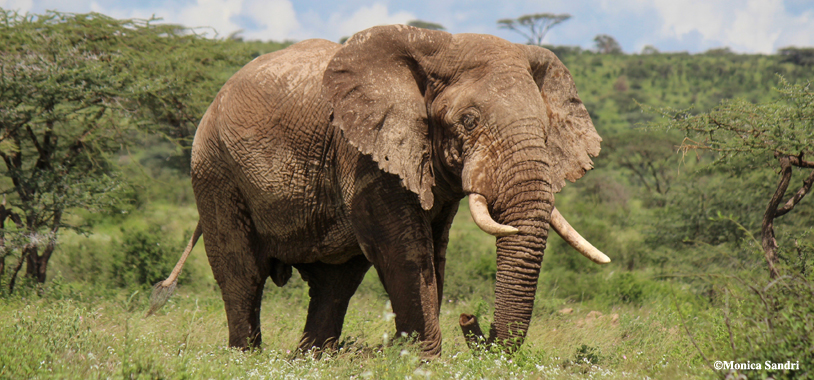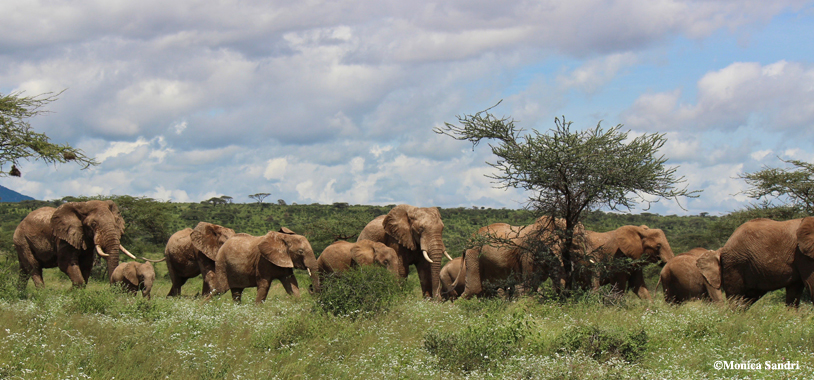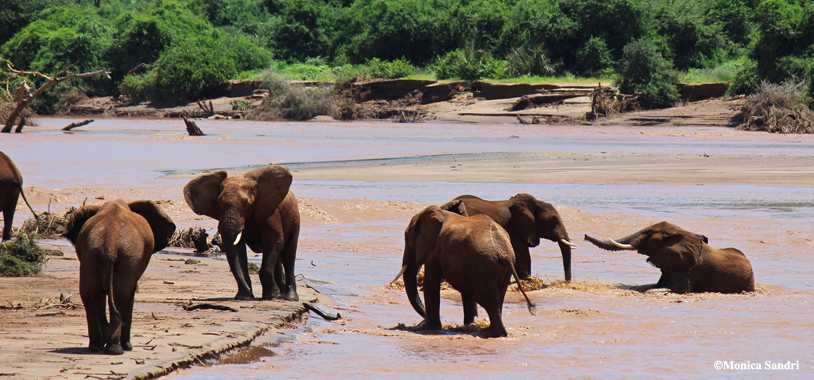The Long-term Monitoring Team here at Save the Elephants has been observing a lot of breeding behavior in Samburu over the past few weeks. Dozens of large males have come into what we call “musth,” a state in which a male elephant’s body and behavior changes and functions to increase sexual activity. But what exactly is musth, and how does one distinguish a musth male versus a non-musth male?
Like many other mammals, cycles in reproduction involve change in hormones, physical appearance, and behavior. In ungulates—or hooved animals, such as deer—males go through a seasonal rut. This period of time typically lasts a few weeks and is characterized by the growth of antlers, increased aggression and male to male competition over females, increased levels of testosterone, and heightened levels of sexual activity. Elephants, however, are a bit different reproductively, as they do not have a discrete breeding season in which all females are sexually fertile and all males are in a heightened state of breeding. Each individual has a specific cycle, meaning that breeding can occur year round. An individual male elephant is likely to go into musth once a year around the same time every year, and is not typically observed in musth until he is in his early twenties. There is, of course, some overlap where multiple males will be in musth around the same time, but this is believed to be random and not the result of an elephant breeding season.
There are clear physical characteristics that indicate that a male elephant is in musth. Elephants have glands on the temporal region of the head that can secrete fluid as response to stimuli, excitement, and stress. However, a male in musth will often have swollen glands that produce copious amounts of thick odorous fluid that can stain the entire side of the face. This is likely a result of increased adrenaline in the blood stream and communicates to other elephants that he is sexually active. Another clear indicator of musth is heavy urine dribbling that wets the sheath of the penis and the inner legs. If this goes on long enough, bulls in musth can develop “Green Penis Syndrome,” a light greenish film that covers the sheath of the penis and produces a strong odor that can be smelled by elephants over a couple miles away.

Musth bull, Miguna Miguna, demonstrates temporal gland secretions, urine dribble, and the “musth” walk
There are also many behaviors indicative of an elephant bull in musth. Males in musth walk and carry themselves with a slow focus, high head, tucked in chin, and open ears that will wave in a specific motion. This motion is meant to waft odors from the temporal gland secretions in the direction of competing males and females in estrus. An elephant in musth may also perform marking behaviors by rubbing their temporal glands on trees and through the continuous dispersal of odorous urine. Males in musth will spend less time feeding than normal, and more time focused on finding a female in estrus. Thus, adult males in musth spend more time around females than they would typically, and can even be seen guarding a female in estrus from other potential suiters. When bulls are no longer in musth, they are more often observed alone or in bachelor groups.
If you are interested in learning more about musth and elephant reproduction, please visit our Publications Archive and refer to the articles listed below!
Goldenberg, S.Z., de Silva, S., Rasmussen, H.B., Douglas-Hamilton, I., and Wittemyer, G
CONTROLLING FOR BEHAVIOURAL STATE REVEALS SOCIAL DYNAMICS AMONG MALE AFRICAN ELEPHANTS, LOXODONTA AFRICANA. (2014)
Animal Behaviour 95 (2014) 111-119
Rasmussen, H.B.
MATING STRATEGIES IN THE MALE AFRICAN ELEPHANT, LOXODONTA AFRICANA. (2001)
Masters thesis, Aarhus Univeristy, Denmark
Rasmussen, H.B.
REPRODUCTIVE TACTICS OF MALE AFRICAN SAVANNAH ELEPHANTS (LOXODONTA AFRICANA) (2005)
Thesis submitted in fulfilment of the requirements for the degree of Doctor of Philosophy at the University of Oxford Michaelmas Term 2005
Rasmussen, H.B., Ganswindt, A., Douglas-Hamilton, I., Vollrath, F.
ENDOCRINE AND BEHAVIORAL CHANGES IN MALE AFRICAN ELEPHANTS: LINKING HORMONE CHANGES TO SEXUAL STATE AND REPRODUCTIVE TACTICS. (2008)
Elsevier. Hormones and Behavior



